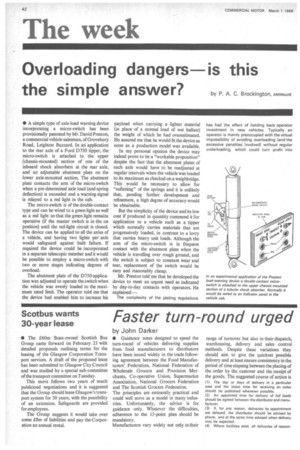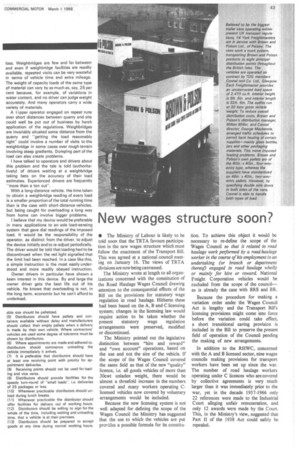Overloading dangers the simple answer? is this
Page 44

Page 45

If you've noticed an error in this article please click here to report it so we can fix it.
by P. A. C. Brockington, AMIMechE
• A simple type of axle-load warning device incorporating a micro-switch has been provisionally patented by Mr. David Preston, a commercial vehicle salesman, of Grovebury Road, Leighton Buzzard. In an application to the rear axle of a Ford D750 tipper, the micro-switch is attached to the upper (chassis-mounted) section of one of the inboard shock absorbers at the rear axle, and an adjustable abutment plate on the lower axle-mounted section. The abutment plate contacts the arm of the micro-switch when a pre-determined axle load (and spring deflection) is exceeded and a warning signal is relayed to a red light in the cab.
The micro-switch is of the double-contact type and can be wired to a green light as well as a red light so that the green light remains operative (if the master switch is in the on position) until the red-light circuit is closed. The device can be applied to all the axles of a vehicle, and having two lights per axle would safeguard against bulb failure. If required the device could be incorporated in a separate telescopic member and it would be possible to employ a micro-switch with two or more stages indicating degrees of overload.
The abutment plate of the D750 application was adjusted to operate the switch when the vehicle was evenly loaded to the maximum rated limit. The operator told me that the device had enabled him to increase his payload when carrying a lighter material (in place of a normal load of wet ballast) the weight of which he had overestimated. He assured me that he would fit the device as soon as a production model was available.
In my personal opinion the device may indeed prove to be a "workable proposition" despite the fact that the abutment plates of each axle would have to be readjusted at regular intervals when the vehicle was loaded to its maximum as checked on a weighbridge. This would be necessary to allow for "softening" of the springs and it is unlikely that, pending further development and refinement, a high degree of accuracy would be obtainable.
But the simplicity of the device and its low cost if produced in quantity commend it for application to a vehicle such as a tipper which normally carries materials that are progressively loaded, in contrast to a lorry that carries heavy unit loads. Although the arm of the micro-switch is in frequent contact with the abutment plate when the vehicle is travelling over rough ground, and the switch is subject to constant wear and tear, replacement of the switch would be easy and reasonably cheap.
Mr. Preston told me that he developed the device to meet an urgent need as indicated by day-to-day contacts with operators. He explained:— The complexity of the plating regulations
has had the effect of holding back operator investment in new vehicles. Typically an operator is mainly preoccupied with the virtual impossibility of avoiding overloading (and the excessive penalties involved) without regular underloading, which could turn profit into loss. Weighbridges are few and far between and even if weighbridge facilities are readily available, repeated visits can be very wasteful in terms of vehicle time and extra mileage. The weight of capacity loads of the same type of material can vary by as much as, say, 25 per cent because, for example, of variations in water content, and no driver can judge weight accurately. And many operators carry a wide variety of materials.
A tipper operator engaged on repeat runs over short distances between quarry arid site could well be put out of business by harsh application of the regulations. Weighbridges are invariably situated some distance from the quarry and "getting the load reasonably right" could involve a number of visits to the weighbridge in some cases over rough terrain involving steep gradients. Dumping part of the load can also create problems.
have talked to operators and drivers about this problem and the tale is told (authoritatively) of drivers waiting at a weighbridge taking bets on the accuracy of their load estimates_ Experienced drivers are frequently "more than a ton out".
With a long-distance vehicle, the time taken to obtain a weighbridge reading of every load is a smaller proportion of the total running time than is the case with short-distance vehicles, but being caught for overloading a long way from home can involve bigger problems.
I believe that my device would be preferable in many applications to an axle load-sensing system that gave dial readings of the imposed load. It would be the responsibility of the operator, as distinct from the driver, to adjust the device initially and to re-adjust periodically. The driver would be told that loading had to be discontinued when the red light signalled that the limit had been reached. In a case like this, a simple instruction is the most easily understood and more readily obeyed instruction.
Owner drivers in particular have shown a keen interest in this device. By and large the owner driver gets the best life out of his vehicle, lie knows that overloading is not, in the long term, economic but he can't afford to underload.








































































































































































